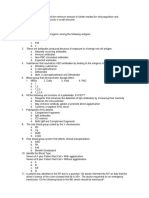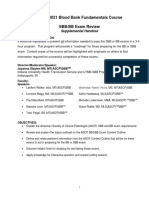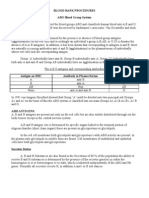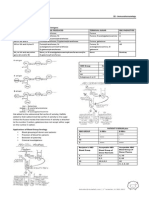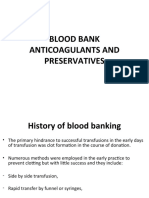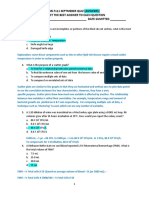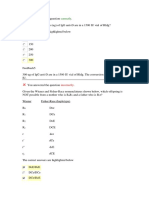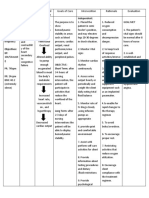Blood Bank 2
Blood Bank 2
Uploaded by
moonfire2009Copyright:
Available Formats
Blood Bank 2
Blood Bank 2
Uploaded by
moonfire2009Original Description:
Copyright
Available Formats
Share this document
Did you find this document useful?
Is this content inappropriate?
Copyright:
Available Formats
Blood Bank 2
Blood Bank 2
Uploaded by
moonfire2009Copyright:
Available Formats
The Osler I nstitute
P}Chaffin (2/12/2013) Blood Bank II page 1
Blood Bank II
D. Joe Chaffin, MD
Cedars-Sinai Medical Center, Los Angeles, CA
Blood Donation & Pretransfusion Testing
I. Blood Donation
A. Allogeneic (homologous) whole blood donation
1. Process tightly regulated by FDA and AABB
2. Donor screening by history
a. FDA-recognized AABB template called donor
history questionnaire (DHQ); see end of this handout
b. Necessary information
1) Full name (generally, formal ID required)
2) Home and/or work address
3) Date of birth/age to make sure over minimum age
a) 17 unless state-approved age 16 donors allowed
4) Reasons for previous deferral
5) Date of last donation
a) > 8 weeks for whole blood
b) > 16 weeks for double red cell collections
c) > 4 weeks for infrequent plasmapheresis
d) > 2 days for single platelet apheresis procedures
e) > 7 days for double/triple platelet apheresis
c. Not required, but often asked
1) Race
2) Social security number
a) Identity theft concerns
b) Alternative ID numbers (unique to donor)
d. HIV information
1) Signs/symptoms and risk factors for HIV
2) Do not to donate if have any risk factors or if just
wanting HIV test
e. Medication list; prevents donations from those taking:
1) Medications with teratogenic potential
2) Medications with infectious risk
3) Medications that damage platelets
f. Informed consent must spell out risks
1) Informed consent is not standardized; individual
centers must develop
g. Donor questions
1) Version 1.3 of DHQ (recognized by FDA in May
2010) contains 48 standardized questions
2) May modify times only to make more restrictive
3) May omit HIV group O questions if donor testing
used is approved to detect group O (see later)
3) May add additional questions at end only
a) These can be more restrictive only; never less
Pathology Review Course
page 2 Blood Bank II P}Chaffin (2/12/2013)
b) Commonly added questions are about
medications/health issues not covered in DHQ
h. Deferrals based on history
1) Permanent deferrals
Infectious Risks
-High-risk behavior for AIDS
(including IVDA, male-male sex, exposure)
-Receiving money or drugs for sex
-Serologic positive for HIV, HBV, HCV, HTLV
-Viral hepatitis after 11
th
birthday
-Transfusion of clotting factor concentrates
(in hemophilia)
-History of Babesiosis or Chagas disease
-Growth hormone from human sources (pre-1985)
-Insulin from bovine sources
-Dura mater graft
Malignancies (see below)
-Leukemia or lymphoma
Teratogens
-Tegison
2) Three year deferrals
Infectious Risks
-Recovered from malaria
-Immigrants from malaria-endemic areas (after 5
consecutive years of living there)
Teratogens
-Soriatane
3) One year deferrals
Infectious Risks
-Needle sticks or other contact with blood
-Sex contact with person with HIV or hepatitis
-Sex contact with person who used needles for drugs
-Rape victims
-Incarcerated > 72 consecutive hours
-Paying money/drugs for sex
-Blood transfusion (Allogeneic); including
plasma/clotting factors in nonhemophiliacs
-Allogeneic transplant of organ/skin/bone
-Living with person with active hepatitis
-Receiving HBIG
-Tattoos/piercings (unless by regulated entity)
-Travel to malaria-endemic areas
-Syphilis or gonorrhea
-Non-prophylactic rabies vaccination
-Travel to Iraq
4) Special situations
a) Malignancy deferrals
The Osler I nstitute
P}Chaffin (2/12/2013) Blood Bank II page 3
i) Medical director discretion (not mandated)
ii) Studies do not show that malignancy can be
transmitted via transfusion
iii) Most defer leukemia/lymphoma permanently,
but some accept cured childhood leukemics
iv) For solid tumors, most defer indefinitely and
consider re-entry after 1-5 years disease-free
v) BCC, localized skin SCC = no deferral.
b) Heart and lung disease
i) No specific mandated deferrals
ii) FDA: Donor should be free of acute lung
disease
ii) AABB: Donor should be free of heart/lung
disease unless determined suitable by
medical director
iii) Medical directors determine acceptability
(time since diagnosis, presence of limitations
on activities, proper medical follow-up)
c) Pregnant women: Defer until 6 wks postpartum.
d) Non-routine dental work: Defer for 72 hours.
e) Questions 46, 47: HIV group O Africa questions
i) Rare in US; no reported cases since 1996
ii) Being born in, living in, or having sexual
contact with someone born or living in these
countries in Africa since 1977 is a permanent
deferral: Benin, Cameroon, Central African
Republic, Chad, Congo, Equatorial Guinea,
Gabon, Kenya, Niger, Nigeria, Senegal,
Togo, or Zambia.
iii) If traveled to these countries since 1977 and
got a blood transfusion: Permanent deferral
iv) HOWEVER, if an FDA-approved anti-HIV
screening test that is sensitive for HIV group
O is used, these questions may be omitted.
5) Defer permanently for vCJD risk all donors who:
a) Lived over 3 months in UK, 1980 to 1996
b) Lived in France over 5 years, 1980 to now
c) Received dura mater transplant, pituitary growth
hormone injections, or bovine insulin injection
d) Were transfused in the UK, 1980 to now
e) Lived in Europe over 5 years, 1980 to now
f) Have family history of CJD or vCJD
g) Were military members/dependents:
i) Stationed at Northern Europe bases
(Germany, UK, Belgium, Netherlands) for 6
months from 1980 to 1990
ii) Stationed at other Europe bases (Greece,
Turkey, Spain, Portugal, Italy) for 6 months
from 1980 to 1996
Pathology Review Course
page 4 Blood Bank II P}Chaffin (2/12/2013)
6) Immunizations
a) General rule: no deferral for killed, toxoid, or
recombinant/synthetic vaccines
b) Live attenuated vaccines (either viral or
bacterial) give deferrals of varying lengths
Immunization Deferrals
Four Weeks: Rubella
Varicella
Two Weeks: Measles
Mumps
Oral polio
Yellow fever
Oral typhoid
No Deferral: Anthrax
Cholera
DPT
Hepatitis A
Hepatitis B
Influenza
Lyme disease
Meningococcus
Pneumococcus
Polio (injection)
RMSF
Typhoid (injection)
12 Months: Unlicensed vaccines
c) Smallpox vaccination
i) Deferrals based on presence/ absence of
vaccine scab and post-vaccination symptoms
ii) No symptoms: defer until scab falls off or 21
days, whichever is longer
iii) With symptoms: defer until 14 days after
symptoms resolve
7) Drugs
a) DHQ only requires questioning about a limited
number of medications
i) Some facilities add more to protect donor
b) DHQ V 1.3 drug deferrals for teratogenicity:
i) Etretinate (Tegison): Permanent deferral
ii) Acitretin (Soriatane): Three year deferral
iii) Isotretinoin (Accutaine): 30 day deferral
iv) Finasteride (Proscar, Propecia): 30 days
v) Dutasteride (Avodart, Jalyn): 6 months
c) DHQ V 1.3 drug deferrals for infection risk:
i) Human pituitary growth hormone: Permanent
ii) Bovine insulin: Permanent
iii) HBIG: 1 year
iv) Unlicensed vaccine: 1 year
The Osler I nstitute
P}Chaffin (2/12/2013) Blood Bank II page 5
d) Aspirin/aspirin like meds for platelets (48 hours)
e) Platelet drug deferrals:
i) Feldene: 48 hours for platelet donors only
ii) Clopidogrel (Plavix) and ticlopidine (Ticlid):
2 weeks for platelet donors only
f) Warfarin is not in DHQ, but most defer donors
about 7 days
g) New drugs are fast arriving
i) Antiplatelet and anticoagulant drugs seen in
donors (e.g., Brilinta, Pradaxa, Xarelto)
ii) Medical director discretion, but most are
deferring like others above
3. Donor screening by physical criteria
a. General appearance
b. Arm check
1) Both arms for evidence of IVDA and venous access
c. Physical requirements:
1) Note that weight, pulse, and BP are NO LONGER
official standards defined by AABB or FDA, and
the numbers listed below are most common practice
Min. Weight: > 110 lbs (50 Kg)
Temperature: < 99.5
o
F (37.5 C)
Pulse: 50-100 (unless athlete)
Blood pressure: < 180/100
HGB or HCT: > 12.5 g/dL or 38%
4. Donation specifics
a. Amount drawn
1) 500 +/- 50 mL (+/ 10%) most common
a) 450 mL bag also used; limit is 450 +/- 45 mL
2) Maximum of 10.5 ml/Kg is allowed by AABB
b. Time limit
1) < 10 minutes best, but no upper limit defined
a) Beyond 15 minutes, plasma/PLTs usually not
made
5. Testing donor blood
a. ABO grouping
b. Rh typing
1) Weak D required if D negative (see BBI)
c. Antibody detection (screen)
1) Unexpected (non-ABO) antibodies in donor serum
2) AABB Standards: If positive, may still use blood,
but only to make products with minimal plasma
(i.e., RBCs ok; cant make FFP, cryo, or platelets).
3) Label must reflect any positive results that are
identified as clinically significant antibodies.
4) Reality: Most hospitals dont want this blood
Pathology Review Course
page 6 Blood Bank II P}Chaffin (2/12/2013)
d. Infectious disease screening (as of 2/2013); see
appendix and further details starting on page 13
1) Hepatitis B Tests
a) HbsAg
b) Anti-HBc
c) HBV nucleic acid test (HBV NAT; in 2013)
2) Hepatitis C Tests:
a) Anti-HCV
4) HCV NAT
3) HIV tests:
a) Anti-HIV-1/2
b) HIV-1 NAT
4) Other tests:
a) Anti-HTLV-I/II
b) West Nile virus NAT
c) Anti-Trypanosoma cruzi (Chagas disease)
d) Serologic test for syphilis
B. Donor reactions
1. Vasovagal reactions
a. Most common reaction (2.5% of healthy donors)
1) More common in young, first-time donors
b. Signs/symptoms
1) Bradycardia with hypotension
2) Syncope
3) Nausea/vomiting
4) Incontinence (uncommon)
c. Treatment is supportive
1) Distinguish from hypotensive shock
2) Elevate feet, cold compresses on neck
2. Hypovolemic shock
a. Extremely uncommon
b. Signs/symptoms
1) Tachycardia with hypotension
2) Loss of consciousness
3) Shock parameters
c. Treatment
1) IV fluids, possibly return blood?
3. Hyperventilation
a. Especially common in first-time donors and children
b. Signs/symptoms
1) Shortness of breath
2) Facial twitching
3) Seizure activity (unusual)
c. Treat with rebreathing (the paper bag thing)
4. Local injuries
a. Hematomas: 0.35% (bruises almost 25%)
b. Nerve injury: less common than bruises (0.9%);
usually resolve on their own
The Osler I nstitute
P}Chaffin (2/12/2013) Blood Bank II page 7
C. Apheresis procedures
1. Separation of blood into components using several
technologies
a. Centrifugation used for donor procedures (others for
therapeutic procedures; see BB Practical section)
b. Separation based on varying density of blood
components
c. Blood drawn into spinning bowl or chamber,
separated, component harvested (all else returned).
2. Targets for donor collection
a. Platelets
b. Plasma
c. Red blood cells
d. Granulocytes
e. Hematopoietic stem cells (after mobilization)
3. Multiple product collections in one procedure possible
a. One RBC unit and one platelet unit
b. One RBC unit and one plasma unit
c. One RBC unit, one platelet unit, one plasma unit
d. Two RBC units
4. Donor requirements
a. Platelet donors
1) Same hemoglobin/hematocrit requirements as
regular donors
2) Donation interval at least 2 days for single product
a) No more than 2 procedures per week
b) No more than 24 procedures per year
c) > 8 weeks after whole blood donation or if
RBCs not returned (unless equipment has less
than 100 mL extracorporeal volume)
d) Physician may waive above if for a particular
patient need (requires written certification).
3) Donation interval 7 days after double/triple products
4) No aspirin/aspirin-effect products in last 48 hrs
5) No clopidogrel or ticlopidine in last 14 days
6) Pre-procedure platelet count > 150,000/L (may use
previous count if not available)
7) Plasma volume loss as per manufacturer
b. Plasma donors
1) Infrequent (> every 4 weeks): = whole blood
2) Serial (< every 4 weeks):
a) Total protein and SPEP check every 4 months
b) Interval > 48 hours; < 2 collections per 7 days
c) Red cell loss < 25 mL/week, < 200 mL/8 weeks
c. Double red cell donors
1) FDA: Assure donor safety
2) Equipment makers have donor requirements that are
OKed by FDA when machine is FDA-cleared
3) Double red cell donors are deferred for 16 weeks
Pathology Review Course
page 8 Blood Bank II P}Chaffin (2/12/2013)
d. Multiple products collected at once
1) FDA-cleared equipment specific donor limits
5. Apheresis donor reactions
a. Citrate effect
1) Citrate anticoagulant binds free calcium
2) Perioral tingling
3) Tetany and arrhythmias uncommon
4) Slow rate of infusion, give oral calcium
b. Hypersensitivity reactions
1) Classic: Hydroxyethyl starch in WBC donors
a) Given to facilitate better separation of WBCs
from RBCs by inducing RBC aggregation
b) Occasional hypersensitivity reactions seen
II. Autologous Blood Collection
A. Preoperative autologous blood donation (PAD)
1. Less screening stringency than allogeneic collections
2. AABB Standards: Dont cross over units into regular
inventory unless exceptional circumstances.
3. More lenient physical criteria (see table below)
4. Testing regulations
a. Infectious disease screening not required unless units
are to be shipped to another facility
1) If not tested, label units NOT TESTED
b. Only first donation in a 30-day period MUST be
tested.
1) All others after that are labeled DONOR TESTED
WITHIN THE LAST 30 DAYS
Parameter Allogeneic Autologous
Donation Interval 8 weeks 72 hours
HB/HCT > 12.5 or 38% > 11 or 33%
Weight > 110 lbs (50 Kg) None
Age > 16 or 17 (varies) None
Infectious Disease
Screening
Required
Not required unless
shipped
History of Disease
or Positive Test
Not eligible Potentially eligible
5. Potential issues with autologous donations
a. Donor reactions
1) More complex donors with more health problems,
so more likelihood of donor complications.
2) Safety of donor during donation is responsibility of
donor center medical director!
b. Clerical errors/transfusion errors
1) Risk of wrong unit going to wrong patient still
present with autologous donations.
2) CAP survey (1992): about 1% of hospitals admitted
making transfusion errors with autologous blood.
The Osler I nstitute
P}Chaffin (2/12/2013) Blood Bank II page 9
3) Systems must be in place to prevent allogeneic units
from being transfused before autologous units.
c. Bacterial contamination
1) Currently a greater risk than HIV or HCV
2) Risk of undetected infection leading to
contamination of unit is not changed by PAD.
d. Cost
1) More costly to patients if transfused and hospitals if
not transfused (wastage).
e. Timing
1) Collections should be completed at least 72 hours
before surgery (preferably sooner).
2) Surgery cancellations, etc, can lead to problems
(freeze units? Let them expire?)
f. Positive infectious disease testing
1) If donor has a reactive test, donor and the requesting
physician must be notified.
2) Autologous collections with reactive testing can
lead to deferral from future allogeneic donations.
B. Acute Normovolemic (isovolemic) hemodilution
1. Primary goal: reduce RBC volume during surgery.
2. Added benefit: Reduces plasma and platelet needs even
more
3. Remove 1 L or more of blood immediately before surgery
a. Collection is done into multiple standard blood bags
and each bag should be monitored for overfill.
b. Standard formulae exist for collection amount;
typically take patients down to HCT 25-28% or so.
1) V = EBV x (H
i
-H
f
)/H
av
(source: Waters JH,
Perioperative Blood Sequestration, AABB 2008)
2) Key:
i) V = volume to remove
ii) EBV = estimated blood volume
iii) H
i
= initial hematocrit
iv) H
f
= final hematocrit
v) H
av
= average hematocrit during process
c. Shelf life:
1) 8 hours at room temperature
2) 24 hours in monitored refrigerator
4. Replace volume with saline/crystalloid (3 ml per 1 ml of
blood removed) or colloid (1 ml per ml of blood removed)
a. Replace the volume unit by unit; i.e., when a unit is
withdrawn, immediately replace volume (dont remove
a bunch of blood and THEN correct the volume).
5. Re-infuse blood near end of surgery.
a. Units usually re-infused in reverse order to how drawn
(i.e., last drawn is first re-infused).
b. If using intraoperative salvage, infuse those units first
Pathology Review Course
page 10 Blood Bank II P}Chaffin (2/12/2013)
6. Indications (not standardized)
a. At least 1 L blood loss anticipated in surgery
b. Hemoglobin at least 12 g/dL
c. No active cardiac or other serious medical disease
d. No infection or bacteremia
7. Potential advantages
a. Better monitoring than PAD, use for riskier patients?
b. Bleeding more dilute blood leads to less overall
hemoglobin loss (not as huge a benefit as predicted).
c. Decreased blood viscosity increases cardiac output and
may improve oxygenation.
d. Coag factors and platelets survive well for short
periods and help hemostasis.
e. May be used in future with blood supplements
(substitutes): Augmented hemodilution
8. Potential disadvantages
a. Requires training of phlebotomist (most commonly
done by anesthesiologist)
b. Units should be labeled with full name, date/time,
medical record number, and FOR AUTOLOGOUS
USE ONLY.
8. Component sequestration:
a. Similar in thought to ANH, but involves harvesting
specific components (platelets, plasma, RBCs) for
targeted transfusion depending on patient needs
b. More complex and requires lots of expertise
C. Intraoperative blood salvage (Cell Saver)
1. Semi automated process; usually involves processing and
concentrating shed blood from suction apparatus
2. Generally indicated for major procedures with large
expected blood losses (cardiac, orthopedics, vascular
surgeries)
a. Requires coordination with team performing recovery
b. Trend: More aggressive use in lower-risk cases
3. Shelf life:
a. 4 hours at room temperature
b. 24 hours in monitored refrigerator
4. Potential problems
a. Air embolus risk
b. Hemolysis of processed blood from excessive suction
in the operative field
c. Coagulation factor activation
5. Historical contraindications; used by some, ignored by
others
a. Bacterial contamination of operative field
b. Malignant cells in field
c. Other contaminants in field (cement, irrigation,
amniotic fluid, etc)
The Osler I nstitute
P}Chaffin (2/12/2013) Blood Bank II page 11
D. Postoperative blood salvage
1. Blood reinfused from operative drains with or without
processing (Im sorry, that is just gross!)
a. Microaggregate filters used during re-infusion
2. Shelf life: 6 hours at room temperature
III. Pretransfusion Testing
A. Basic outline
1. Requires actions by supplier, phlebotomists, transfusion
services, and infusing staff
2. Crossmatch is final check of everyones work.
a. Main reason for crossmatch: ABO compatibility!
B. Testing recipient blood
1. Request forms
a. Identification critical
1) Number one cause of fatal HTRs: clerical error!
b. No identification labeling errors are acceptable.
1) Transfusion 1997 37; 1169-72: Mislabeled
specimens 40X more likely to have a blood
grouping discrepancy!
c. Should tell whats needed and when needed, ordering
provider, and any modifications (washing, irradiation,
etc.) needed
2. Specimen
a. Serum or plasma (red top vs lavender top)
1) Either ok, but non-tube technologies prefer plasma.
b. Required q 3 days with transfusion or pregnancy in
the last three months
c. Retained 7 days after transfusion in the blood bank.
3. Type and hold (T&H)
a. ABO/Rh check only
b. Hold means to hold sample, not units.
c. Uncommonly used or even offered now
4. Type and screen (T&S)
a. Includes:
1) Records check
a) Previous antibodies or compatibility problems
b) Not to be used to determine current ABO/Rh,
but should be compared to current results.
2) ABO testing
Pathology Review Course
page 12 Blood Bank II P}Chaffin (2/12/2013)
a) Forward and reverse grouping
b) Resolve any discrepancies
3) Rh typing
a) No weak D test required if D negative.
Common exception: obstetric patients
4) Antibody screen
a) Unexpected (non-ABO) antibody check
b) Panel of 2, 3, or 4 RBC-phenotyped donors
i) Always group O
ii) Most common combination:
Cell I: R
1
R
1
Cell II: R
2
R
2
Cell III: rr
c) Antigens represented required by FDA:
i) D, C, c, E, e, Fy
a
, Fy
b
, Jk
a
, Jk
b
, K, k, Le
a
, Le
b
,
M, N, P1, S, s
d) IAT phase is required, IS/37 C are not required.
e) If positive, identify antibody (see BB Practical)
5. Type and crossmatch (T&C)
a. Everything in T&S + crossmatch
b. Crossmatch types
1) Major crossmatch (or just crossmatch)
a) Recipient serum vs donor RBCs
b) Final check of ABO compatibility
c) IAT/AHG phase (full crossmatch) not required
if antibody screen is negative
d) Required if 2 ml of RBCs in product.
2) Minor crossmatch
a) Donor serum vs. recipient RBCs
b) Not required
3) Units go back into inventory if not used.
6. Converting a T&S to a T&C
a. ABO check only required (if antibody screen negative)
1) Immediate spin crossmatch
a) Donor RBCs/recipient serum centrifuged at
room temp
2) Computer crossmatch (see below)
7. Variations to the above
a. Infants less than four months of age (neonatal period)
1) Babys antibodies = moms IgG antibodies.
2) Initial testing:
a) Infants ABO (red cell grouping only)
b) Infant Rh type
c) Antibody screen on moms or babys serum.
3) If screen neg, repeat initial testing and crossmatch
not needed in same hospital stay up until age 4
months
4) Serum grouping not required unless non-group O
baby receives non-group O RBCs
The Osler I nstitute
P}Chaffin (2/12/2013) Blood Bank II page 13
b. Electronic (computer) crossmatch
1) Computer system verifies ABO compatibility
between donor and recipient (replaces immediate
spin crossmatch)
2) Requires a patient with a negative antibody screen
both now and in the past
3) Requires two separate ABO determinations of the
patient (either on different specimens or repeated on
the same specimen with different reagents)
4) Requires a properly validated computer system
8. Reasons for positive major crossmatch
a. With positive antibody screen
1) Alloantibodies
2) Autoantibodies
3) Reagent antibodies
4) Rouleaux and other false positives
b. With negative antibody screen
1) ABO incompatibility
2) Antibodies vs low-incidence antigens
3) Positive donor DAT
9. Routine blood order templates
a. Maximum Surgical Blood Ordering Schedule
(MSBOS), or just routine surgical blood orders
b. Multidisciplinary and institution-specific
c. Gives surgeons / blood bankers a guide to how many
RBC units to crossmatch (or not) for a given procedure
IV. Transfusion-transmitted Diseases (See April
2011 Podcast)
A. Current risk of disease transmission
1. For perspective, risk of acute hemolytic reaction stated as
1 in 25,000 transfusions
2. Risk of dying in the hospital from something other than
transfusion problem: 6 per 1000!
Organism Current Risk Estimate
HIV-1 1 in 1,467,000 (2010)
Hepatitis B 1 in 355,000-357,000 (2009)
Hepatitis C 1 in 1,149,000 (2010)
HTLV-I 1 in 3,000,000
HIV-2 Remote
WNV Remote
Syphilis Remote
T. cruzi Unknown, likely remote
Bacteria 1 in 75,000 platelet transfusions
1 in 500,000 RBC transfusions
B. Hepatitis viruses
1. Hepatitis A virus
a. Fecal-oral transmission (30 day incubation)
b. Generally not a big blood banking problem (not tested)
Pathology Review Course
page 14 Blood Bank II P}Chaffin (2/12/2013)
c. Some concern in pooled products
1) Solvent-detergent treatment doesnt deactivate
HAV (nonenveloped).
2) Transmission possible in pooled factor concentrates
d. Not prone to chronicity like HBV and especially HCV
2. Hepatitis B virus
a. DNA virus (Hepadnavirus)
b. Blood transmission, intimate contact less likely
c. Both cellular and plasma components transmit.
d. Incubation period: approximately 8-12 weeks
e. Clinical
1) Primary infection may be subclinical (65%) or only
mild (jaundice, nausea, fatigue, dark urine).
2) Fulminant presentation rare
3) Chronic infection (carrier state) much less likely
than with HCV (< 5% of adult infections)
a) Greatly decreased carriers since routine
vaccination
b) 400 million worldwide carriers, per WHO
f. Current testing (see appendix)
1) Anti-HBc EIA/ChLIA and HBsAg EIA/ChLIA
a) Confirmatory test for HBsAg: neutralization
b) No confirmatory test for anti-HBc
2) No anti-HBsAg testing (vaccinated donors positive)
3) HBV NAT required in 2013
4) HBV is currently the most likely of the major
viruses to be transmitted via transfusion!
g. Serology patterns below
HBV
DNA
HBsAg
ANTI-HBc
(TOTAL)
ANTI-HBc
(IGM)
ANTI-
HBsAg
INTERPRETATION
Incubation
+ + + + Acute infection
+ + Recovered infection
+/ + + Carrier
+ Vaccinated
+
Probable false pos.,possible
early or chronic infection
3. Hepatitis C virus
a. RNA virus
b. 0.5-1.0% of US blood donors
c. Both cellular and plasma components transmit.
d. Strong association with chronic hepatitis (75%),
cirrhosis, and hepatocellular carcinoma (>HBV)
1) Currently #1 reason for hepatic transplant in the US.
2) Initial presentation mild or asymptomatic
e. Donor testing (see appendix)
1) Antibody test is anti-HCV (EIA/ChLIA)
The Osler I nstitute
P}Chaffin (2/12/2013) Blood Bank II page 15
a) Reactive anti-HCV confirmed by Recombinant
ImmunoBlot Assay (RIBA); current US shortage
2) Window period with antibody test: 70-80 days
a) During some of this time, HCV RNA is
detectable by PCR testing, and the virus is
transmissible by transfusion (see below).
3) Also must use nucleic acid testing (HCV NAT)
a) Window period from 70-80 days to 10-30 days
4) See appendix for deferral guidelines
4. Other hepatitis viruses we dont test for:
a. Hepatitis D virus
1) Formerly known as delta agent
2) Blood transmission
3) Defective virus (requires coating with HBsAg in
order to cause disease).
b. Hepatitis E virus
1) Fecal-oral transmission
2) Epidemics in India and Asia; rare transfusion
transmission
C. Retroviruses
1. HIV-1 and HIV-2
a. RNA retrovirus identified in 1984
1) Hemophiliacs and homosexual men first
2) Transfusion, sexual contact, breast-feeding, blood
b. Clinical/pathophysiology
1) Symptoms in acute infection: flu-like
2) LONG asymptomatic period (often over ten years),
then rapid immune compromise
3) Damage caused by attack on CD4+ lymphocytes
4) Death secondary to opportunistic infections or
malignancies like Kaposis or CNS lymphoma
c. Testing
1) Antibody testing
a) Required since 1985
b) Window period = 20-22 days
2) Organism testing
a) HIV-1 antigen (p24) testing March 1996
Reduced window period to about 16 days
b) p24 testing replaced in 1999-2000 by nucleic
acid testing for HIV RNA (HIV NAT)
Reduction of window period to 9-10 days
d. Both cellular and plasma products can transmit HIV-1
e. See appendix for deferral guidelines
f. HIV-2
1) Related virus found originally in West Africa
2) Really, really rare
3) Less readily transmitted vs HIV-1, with less AIDS
4) No licensed confirmatory test
Pathology Review Course
page 16 Blood Bank II P}Chaffin (2/12/2013)
2. HTLV I/II
a. Transmission through cellular products only
b. HTLV-I disease associations
1) Adult T-cell leukemia/lymphoma (ATLL)
2) HTLV-associated myelopathy (HAM; formerly
called tropical spastic paraparesis)
c. HTLV-II: no clear-cut disease associations
d. Both transmitted readily, but actual post-transfusion
disease is very unlikely (~99% of infected no disease)
e. See testing discussion in appendix
D. Other organisms for which we test:
1. West Nile virus (WNV)
a. RNA virus causing disease in birds; humans incidental
(most flu-like, some meningitis/encephalitis)
b. 2012 large increase in cases in US
c. Testing done via pooled NAT (until high risk of
disease in area, then single donor)
d. Deferrals:
1) Confirmed/suspected WNV infection: 28 days from
symptom onset or 14 days after symptoms resolved
2) Positive test only: 120 days from test date
2. Trypanosoma cruzii (Chagas disease)
a. Transmitted through bite of reduviid bug (kissing
bug) in Central/South America
b. Potentially growing problem with immigration
(roughly 1 in 20,000 donors, higher in immigrants)
c. Specific question on donor questionnaire (permanent
deferral for history of Chagas disease); the problem is
that many are asymptomatic.
d. Screening test (EIA) required as of 2011
1) Testing allowed to be one time per lifetime of donor
3. Treponema pallidum
a. Organism doesnt survive well in refrigerated storage
(48-96 hours); not considered a large problem
b. Surrogate marker for high-risk behavior
c. See testing discussion in appendix
4. Cytomegalovirus (CMV)
a. Extremely common DNA virus (> 50% are exposed)
that lives in WBCs only (monocytes).
b. Causes severe infections in immunocompromised
adults and neonates, but minimal disease in healthy
people (may have cold-like symptoms)
c. Prevent with seronegative donors and leukocyte
reduced products (see discussion in BB III)
d. Testing not required but available
5. Parvovirus B19
a. Primarily infects RBCs
1) Entry through P antigen receptor
b. Fifth disease in children, red cell aplasia in adults
The Osler I nstitute
P}Chaffin (2/12/2013) Blood Bank II page 17
c. Nonenveloped, so not destroyed by solvent-detergent
treatment (concern in pooled treated products)
d. Source and recovered plasma for plasma derivative
manufacture are tested for Parvovirus via NAT
E. Other organisms for which we dont test:
1. Prion disease
a. Prion: probably an infectious protein particle
b. Creutzfeldt-Jakob Disease (CJD)
1) Mostly sporadic (occasionally familial) spongiform
encephalopathy, nearly universally fatal
2) Found in older patients
3) Long disease course
4) Transmission via transfusion theoretical only
c. Variant CJD (vCJD)
1) Emerging syndrome in the United Kingdom
2) Caused by prion that causes bovine spongiform
encephalopathy (mad cow disease)
3) Distinct from CJD (younger, more rapid course)
4) Transfusion transmission proven
5) US deferral of many donors who lived in UK or
Europe since 1980 (see earlier)
6) Led to universal leukoreduction in many countries
(but current research suggests prion may also be
found in plasma)
2. Plasmodiumspecies
a. Malaria is readily transmissible through transfusion.
b. No effective screening except by history.
c. See earlier for deferral guidelines
3. Babesia species
a. Tick-borne intraerythrocytic parasite infection
b. Huge concern in endemic areas in East currently; pilot
studies to test donors
c. Caused 10 cases of transfusion fatality from 2007-11
d. Screen via history (permanent deferral)
Pathology Review Course
page 18 Blood Bank II P}Chaffin (2/12/2013)
APPENDIX I
Blood Donor Infectious Disease Screening Tests
Agent Screening Test(s) Confirmatory Test(s) Discussion
HIV Anti-HIV 1/2
(EIA/ChLIA)
HIV-1 NAT
(PCR, TMA)
Western blot (WB) or
IFA for HIV-1
HIV-2 EIA required
after reactive anti-
HIV-1/2
Individual donor
NAT (if not done)
RR anti-HIV + Reactive HIV NAT =
permanent deferral
RR anti-HIV + WB neg/indeterm + NR HIV
NAT = indefinite deferral (may try to re-enter
in 8 weeks)
RR anti-HIV + positive WB = permanent
deferral
NR anti-HIV + reactive HIV NAT = indefinite
deferral (may try to re-enter in 8 weeks)
HCV Anti-HCV
(EIA/ChLIA)
HCV NAT
(PCR/TMA)
RIBA for anti-HCV
Individual donor
NAT (if not done)
RR anti-HCV + reactive HCV NAT =
permanent deferral
RR anti-HCV + RIBA neg/indeterm + NR
HCV NAT = indefinite deferral (may try to re-
enter in 6 months)
RR anti-HCV + positive RIBA = permanent
deferral
NR anti-HCV + reactive HCV NAT =
indefinite deferral (may try to re-enter in 6
months)
HBV HBsAg
(EIA/ChLIA)
Anti-HBc
(EIA/ChLIA)
NAT HBV
(Required in
2013)
Neutralization for
HBsAg
None for anti-HBc
Individual donor
NAT (if not done)
RR anti-HBc x 1 = no deferral
RR anti-HBc x 2 = permanent deferral
RR anti-HBc + RR HBsAg = permanent
deferral
RR HBsAg + confirmed neutralization =
permanent deferral
RR HBsAg + nonconfirmed neutralization =
retest in > 8 weeks
NAT HBV reactive = permanent deferral
HTLV-I/II Anti-HTLV-I/II
(EIA/ChLIA/mic
roEIA)
None licensed Reactive anti-HTLV-I/II x 1 = no deferral
Reactive anti-HTLV-I/II x 2 = permanent
deferral
Syphilis (T.
pallidum)
Many (hemag-
glutination, EIA,
RPR)
Usually FTA or TP-
PA
Reactive screen + negative confirm = no
definite deferral (though many will defer)
Reactive screen + reactive confirm = at least 1
year deferral (after treatment)
West Nile
Virus
WNV NAT
(PCR)
Individual donor
NAT (if not done)
Reactive NAT = 120 day deferral (if
asymptomatic)
Chagas Disease
(T. cruzi)
T. cruzi
EIA/ChLIA
Enzyme Strip Assay
(ESA); FDA
approved
Many use RIPA (not
FDA approved)
Reactive EIA = permanent deferral
ESA and RIPA results only for counseling
No re-entry currently
Testing may be once per lifetime only
RR: Repeat reactive
EIA/ChLIA: Enzyme immunoassay or chemiluminescent immunoassay
PCR/TMA: Polymerase chain reaction or transcription-mediated amplification
IFA: Immunofluoresence assay
RIBA: Recombinant immunoblot assay
FTA: Fluorescent treponemal antibody
TP-PA: Treponema pallidum particle agglutination
RIPA: Radioimmunoprecipitation assay
RPR: Rapid plasma reagin
Sources: AABB Technical Manual, 17
th
ed, www.fda.gov
The Osler I nstitute
P}Chaffin (2/12/2013) Blood Bank II page 19
APPENDIX
AABB Uniform Donor History Questionnaire (V 1.3, AABB 2008)
Question Comment
Are you:
1. Feeling healthy and well today?
2. Currently taking an antibiotic? Medical director discretion
3. Currently taking any other medication for an
infection?
Same
Please read the Medication Deferral List
4. Are you now taking or have you ever taken any
medications on the Medication Deferral List?
See deferrals listed
previously in notes
5. Have you read the educational materials? Includes HIV risk info
In the past 48 hours
6. Have you taken aspirin or anything that has
aspirin in it?
48 hour deferral as sole
source of platelets per FDA
In the past 6 weeks
7. Female donors: Have you been pregnant or are
you pregnant now? (Males: check I am male.)
This question (as well as #24
and #34) serves as a
check to make sure
donors are paying attention
In the past 8 weeks have you
8. Donated blood, platelets or plasma? See details in notes
9. Had any vaccinations or other shots? See notes
10. Had contact with someone who had a smallpox
vaccination?
No deferral unless
symptomatic. If so, defer at
least 14 days.
In the past 16 weeks
11. Have you donated a double unit of red cells
using an apheresis machine?
16 week donation interval
In the past 12 months have you
12. Had a blood transfusion? 1-year deferral
13. Had a transplant such as organ, tissue, or bone
marrow?
1-year deferral
14. Had a graft such as bone or skin? 1-year deferral (unless dura
mater, then permanent)
15. Come into contact with someone elses blood? 1-year deferral
16. Had an accidental needle-stick? 1-year deferral
17. Had sexual contact with anyone who has
HIV/AIDS or has had a positive test for the
HIV/AIDS virus?
17-23 are all 1-year
deferrals from the time of
last contact
18. Had sexual contact with a prostitute or anyone
else who takes money or drugs or other payment
for sex?
19. Had sexual contact with anyone who has ever
used needles to take drugs or steroids, or
anything not prescribed by their doctor?
20. Had sexual contact with anyone who has
hemophilia or has used clotting factor
concentrates?
The Osler I nstitute
P}Chaffin (2/12/2013) Blood Bank II page 20
21. Female donors: Had sexual contact with a male
who has ever had sexual contact with another
male? (Males: check I am male.)
22. Had sexual contact with a person who has
hepatitis?
23. Lived with a person who has hepatitis? 1 year deferral, unless
asymptomatic Hepatitis C
24. Had a tattoo? For 24-25, these can be
allowed if certified that
procedure was done by
state-certified entity using
sterile, one-time use needles
25. Had ear or body piercing?
26. Had or been treated for syphilis or gonorrhea? 1 year following treatment
completion (or from time of
positive test if no symptoms)
27. Been in juvenile detention, lockup, jail, or
prison for more than 72 hours?
72 hours is consecutive
In the past three years have you
28. Been outside the United States or Canada? Primarily for malaria
exposure or vCJD risk
From 1980 through 1996,
29. Did you spend time that adds up to three (3)
months or more in the United Kingdom?
(Review list of countries in the UK)
For 29-32, see vCJD
discussion in notes;
permanent deferral
30. Were you a member of the U.S. military, a
civilian military employee, or a dependent of a
member of the U.S. military?
From 1980 to the present, did you
31. Spend time that adds up to five (5) years or
more in Europe? (Review list of countries in
Europe.)
32. Receive a blood transfusion in the United
Kingdom or France? (Review list of countries
in the UK.)
From 1977 to the present, have you
33. Received money, drugs, or other payment for
sex?
Permanent deferral
34. Male donors: had sexual contact with another
male, even once? (Females: check I am
female.)
Currently controversial, but
permanent deferral
Have you EVER
35. Had a positive test for the HIV/AIDS virus? May require investigation to
determine if true positive. If
so, permanent deferral
36. Used needles to take drugs, steroids, or anything
not prescribed by your doctor?
Permanent deferral.
Includes obvious physical
stigmata of IVDA (needle
tracks)
37. Used clotting factor concentrates? Permanent if for hemophilia,
otherwise 1 year deferral
The Osler I nstitute
P}Chaffin (2/12/2013) Blood Bank II page 21
38. Had hepatitis? Permanent deferral after
11
th
birthday
39. Had malaria? 3 year deferral
40. Had Chagas disease? Permanent deferral
41. Had babesiosis? Permanent deferral
42. Received a dura mater (or brain covering) graft? Permanent deferral for
vCJD possibility
43. Had any type of cancer, including leukemia? Medical director discretion
(see discussion in notes)
44. Had any problems with your heart or lungs? Medical director discretion
(see discussion in notes)
45. Had a bleeding condition or a blood disease? If hemophilia, permanent
deferral. Otherwise, medical
director discretion.
46. Had sexual contact with anyone who was born
in or lived in Africa?
See HIV group O discussion
in notes. Can be omitted if
anti-HIV test used detects
group O.
47. Been in Africa? HIV group O discusssion
48. Have any of your relatives had Creutzfeldt-
Jakob disease?
Permanent deferral
Medication Deferral List
(Source: http://www.aabb.org/resources/donation/questionnaires/Pages/dhqaabb.aspx)
Please tell us if you are now taking or if you have EVER taken any of these medications:
Proscar (finasteride) usually given for prostate gland enlargement
Avodart, Jalyn (dutasteride) usually given for prostate enlargement
Propecia (finasteride) usually given for baldness
Accutane (Amnesteem, Claravis, Sotret, isotretinoin) usually given for severe acne
Soriatane (acitretin) usually given for severe psoriasis
Tegison (etretinate) usually given for severe psoriasis
Growth Hormone from Human Pituitary Glands used usually for children with delayed
or impaired growth
Insulin from Cows (Bovine, or Beef, Insulin) used to treat diabetes
Hepatitis B Immune Globulin given following an exposure to hepatitis B.
NOTE: This is different from the hepatitis B vaccine which is a series of 3 injections
given over a 6 month period to prevent future infection from exposures to hepatitis B.
Plavix (clopidogrel) and Ticlid (ticlopidine) inhibits platelet function; used to reduce the
chance for heart attack and stroke.
Feldene given for mild to moderate arthritis pain
Experimental Medication or Unlicensed (Experimental) Vaccine usually associated
with a research protocol
You might also like
- Blood Banking QuestionsDocument18 pagesBlood Banking QuestionsDefensor Pison Gringgo83% (47)
- ASCP Review Course: Review Questions: Blood Banking and Transfusion MedicineDocument18 pagesASCP Review Course: Review Questions: Blood Banking and Transfusion MedicineMarl Estrada100% (1)
- Questionnaire (ISBB)Document14 pagesQuestionnaire (ISBB)Angelo Mercede100% (2)
- Medtecg Sir Judecribd NiDocument11 pagesMedtecg Sir Judecribd NiSUPPLY OFFICERNo ratings yet
- AABB 2021 Blood Bank Fundamentals Course SBB/BB Exam Review: Supplemental HandoutDocument51 pagesAABB 2021 Blood Bank Fundamentals Course SBB/BB Exam Review: Supplemental HandoutDyne Sabijon100% (2)
- MCQ's Blood BankDocument74 pagesMCQ's Blood BankAlireza Goodazri100% (2)
- Blood Bank PracticalDocument24 pagesBlood Bank Practicalmoonfire2009100% (2)
- Blood Bank Harmening Chapter 10Document14 pagesBlood Bank Harmening Chapter 10ichummy19100% (3)
- Blood Bank Case StudyDocument17 pagesBlood Bank Case StudyMelissa Harding25% (4)
- ABO Discrepancies QuizDocument4 pagesABO Discrepancies Quizwe445100% (1)
- Blood Banking ReviewDocument442 pagesBlood Banking ReviewMayra Flor100% (3)
- Blood Bank Practical Panel CasesDocument23 pagesBlood Bank Practical Panel CasesMiguel Vasquez0% (1)
- Blood BankingDocument10 pagesBlood BankingSheen Amboy100% (1)
- Detection of AntibodiesDocument7 pagesDetection of AntibodiesJezreeljeanne Largo Caparoso100% (1)
- Reviewer - Immunohematology - Part 1Document16 pagesReviewer - Immunohematology - Part 1Joshua TrinidadNo ratings yet
- Urinalysis and Body Fluids for Cls & MltFrom EverandUrinalysis and Body Fluids for Cls & MltNo ratings yet
- 8 - Blood Banking and SerologyDocument4 pages8 - Blood Banking and SerologyRanndolf Javier80% (5)
- Blood Bank 3Document20 pagesBlood Bank 3moonfire2009100% (2)
- Blood Bank QuizDocument13 pagesBlood Bank Quizdimalawang.af100% (1)
- Immunohema QuestionDocument19 pagesImmunohema QuestionLily Beauty100% (1)
- Blood Bank Guy Blood GroupsDocument19 pagesBlood Bank Guy Blood GroupsJessica TuNo ratings yet
- ABO Discrepancy Assignment Spring 2021Document5 pagesABO Discrepancy Assignment Spring 2021Ciarra Asuncion100% (2)
- Transfusion TherapyDocument14 pagesTransfusion TherapyCMLNo ratings yet
- Immunohematology and Blood Banking Techniques Class NotesDocument172 pagesImmunohematology and Blood Banking Techniques Class NotesManoj Kumar Patro67% (3)
- Blood Banking and Serology and Immunology Refresher Exam With AnswersDocument8 pagesBlood Banking and Serology and Immunology Refresher Exam With AnswersJohn Rhel Denque100% (2)
- Blood Bank ProceduresDocument33 pagesBlood Bank Proceduresninadroy2844100% (20)
- Blood Bank ProceduresDocument33 pagesBlood Bank Procedures99noname100% (1)
- Questions: 1: Blood Bank - Blood Group SystemsDocument10 pagesQuestions: 1: Blood Bank - Blood Group SystemsVincent Reyes100% (1)
- RH BLOOD GROUPDocument23 pagesRH BLOOD GROUPWho KnowsNo ratings yet
- 22 - ImmunohematologyDocument6 pages22 - Immunohematologyhamadadodo7No ratings yet
- Final Coaching Powerpoint Presentation by Ms. PiconesDocument458 pagesFinal Coaching Powerpoint Presentation by Ms. PiconesMark Justin Ocampo100% (2)
- ABO Blood Group System RH Blood Group SystemDocument2 pagesABO Blood Group System RH Blood Group SystemDannie Desaca100% (1)
- ImmunohematologyDocument11 pagesImmunohematologydtimtiman100% (1)
- Other Blood Group System AssignmentDocument5 pagesOther Blood Group System AssignmentMary Christelle100% (1)
- Blood Banking and Serology and Immunology - Refresher Exam With AnswersDocument8 pagesBlood Banking and Serology and Immunology - Refresher Exam With AnswersPaul Espinosa88% (26)
- Is BB Final Coaching NotesDocument8 pagesIs BB Final Coaching NotesLeomill Mendiola100% (1)
- Resolution of Abo DiscrepanciesDocument4 pagesResolution of Abo DiscrepanciesPatrick MabugatNo ratings yet
- MLT Blood Bank Exam 1 FullDocument4 pagesMLT Blood Bank Exam 1 Fullkasdf gre bbtNo ratings yet
- Immunohema Prelims Question BankDocument14 pagesImmunohema Prelims Question BankHabib Ullah100% (1)
- Anticoagulants Used in Blood BankDocument27 pagesAnticoagulants Used in Blood Banklovi bahunNo ratings yet
- MUST To KNOW in Immunohematology Blood BankingDocument18 pagesMUST To KNOW in Immunohematology Blood BankingDanielJeremy DelaCruz Paragas79% (14)
- Human Platelet AntigenDocument56 pagesHuman Platelet AntigenMohandoss Murugesan100% (4)
- ML7111 MCQs Answers Sep 2019Document10 pagesML7111 MCQs Answers Sep 2019Cleo Salvador100% (2)
- Cross MatchingDocument3 pagesCross MatchingTP RMad100% (7)
- Q and A in Antibody IdentificationDocument29 pagesQ and A in Antibody IdentificationMohamed ElmasryNo ratings yet
- Antibody IdentificationDocument27 pagesAntibody Identificationhamaada100% (2)
- Blood BankDocument32 pagesBlood Bankpikachu100% (1)
- ASCPi Recalls Sep 23 2017Document3 pagesASCPi Recalls Sep 23 2017Jaine Salonga100% (1)
- Blood BankDocument19 pagesBlood Bankmoonfire2009100% (2)
- Wuchereria Bancrofti: 1-Blood of Microfilaria Infection Diagnostic WithDocument7 pagesWuchereria Bancrofti: 1-Blood of Microfilaria Infection Diagnostic Withman3o0ol75% (4)
- Hematology PDFDocument11 pagesHematology PDFMaybelline Tan100% (1)
- Cross Match TechniqueDocument5 pagesCross Match TechniqueANDREW MWITI100% (3)
- Antibody IdentificationDocument74 pagesAntibody IdentificationNilver Zenteno100% (4)
- Mtap - Immunohema Transfusion MedicineDocument9 pagesMtap - Immunohema Transfusion MedicineMoira Pauline LibroraniaNo ratings yet
- Blood Bank Technology Specialist - The Comprehensive Guide: Vanguard ProfessionalsFrom EverandBlood Bank Technology Specialist - The Comprehensive Guide: Vanguard ProfessionalsNo ratings yet
- Tietz's Applied Laboratory MedicineFrom EverandTietz's Applied Laboratory MedicineMitchell G. ScottRating: 3 out of 5 stars3/5 (1)
- Local Media4071061158702283415Document7 pagesLocal Media4071061158702283415Haniya KhanNo ratings yet
- Donor Selection and Blood CollectionDocument6 pagesDonor Selection and Blood Collectionhcp8s6tmn9No ratings yet
- Criteria For Donor SelectionDocument6 pagesCriteria For Donor SelectionSteveCantaIcoNo ratings yet
- Helicobacter PyloriDocument4 pagesHelicobacter Pylorimoonfire2009No ratings yet
- Medical Histology MCQSDocument3 pagesMedical Histology MCQSmoonfire200983% (12)
- Helicobacter PyloriDocument4 pagesHelicobacter Pylorimoonfire2009No ratings yet
- Blood BankDocument19 pagesBlood Bankmoonfire2009100% (2)
- Clinical LaboratoryDocument24 pagesClinical Laboratorymoonfire2009100% (2)
- BileDocument3 pagesBilemoonfire2009100% (1)
- Common Inherited Coagulation DisordersDocument1 pageCommon Inherited Coagulation Disordersmoonfire2009No ratings yet
- Hepatitis CDocument2 pagesHepatitis Cmoonfire2009No ratings yet
- Blood Cells MorphologyDocument20 pagesBlood Cells Morphologymoonfire2009No ratings yet
- 5Document2 pages5Academic ServicesNo ratings yet
- RPT Biology Form 5Document18 pagesRPT Biology Form 5Mohamad Khairie Rano IbrahimNo ratings yet
- Vaccine Safety HandbookDocument40 pagesVaccine Safety HandbookleostraussNo ratings yet
- Palodent EngDocument3 pagesPalodent EngDrg ToddyNo ratings yet
- Exercises 8-10 (By Dr. N. Tubon) PDFDocument25 pagesExercises 8-10 (By Dr. N. Tubon) PDFLoren100% (1)
- Thyroid StormDocument3 pagesThyroid StormSuprit SnNo ratings yet
- Failures in Fixed Partial Denture A ReviewDocument8 pagesFailures in Fixed Partial Denture A ReviewInternational Journal of Innovative Science and Research TechnologyNo ratings yet
- Cleft Lip and Cleft PalateDocument16 pagesCleft Lip and Cleft Palatemacuka08100% (3)
- Diamante de La Muerte 2020Document24 pagesDiamante de La Muerte 2020jonathan ruizNo ratings yet
- Toxic Plants Goats060210Document4 pagesToxic Plants Goats060210HelGusaNo ratings yet
- Enfermedad Inflamatoria IntestinalDocument14 pagesEnfermedad Inflamatoria IntestinalMi5kaNo ratings yet
- Biology Matric Class NotesDocument38 pagesBiology Matric Class NotesNaveed Haroon BhachoNo ratings yet
- Mufia Muin, Prema Hapsari Hidayati, Indah Lestari, Gina Isni D Iskandar, Nurul Faiqah, Agung SukriadiDocument5 pagesMufia Muin, Prema Hapsari Hidayati, Indah Lestari, Gina Isni D Iskandar, Nurul Faiqah, Agung SukriadimufiaNo ratings yet
- Major Disease of Onion in Somali RegionDocument15 pagesMajor Disease of Onion in Somali Regionfarhan abdiNo ratings yet
- Understanding Hormone Highs and Lows PhoDocument4 pagesUnderstanding Hormone Highs and Lows PhoБежовска СањаNo ratings yet
- Automated Versus Manual Platelet Count in Aden 2161 0681-3-149Document4 pagesAutomated Versus Manual Platelet Count in Aden 2161 0681-3-149Jeffry MaglalangNo ratings yet
- Informed Consent - Filler - RadiesseDocument7 pagesInformed Consent - Filler - RadiesseAshraf AboNo ratings yet
- Novartis vs. Union of IndiaDocument2 pagesNovartis vs. Union of IndiaGS MaggyNo ratings yet
- Cues Nursing Diagnosis Background Knowledge Goals of Care Intervention Rationale EvaluationDocument2 pagesCues Nursing Diagnosis Background Knowledge Goals of Care Intervention Rationale EvaluationCharles Dave AgustinNo ratings yet
- Branches June LowDocument8 pagesBranches June Lowapi-243912756No ratings yet
- ProjectDocument70 pagesProjectRumi BegumNo ratings yet
- MSDS Castrol Perfecto XPG 32Document4 pagesMSDS Castrol Perfecto XPG 32Teguh SNo ratings yet
- Q3-PPT-HEALTH10 - Positive Impact of Health Initiatives (Module 2)Document21 pagesQ3-PPT-HEALTH10 - Positive Impact of Health Initiatives (Module 2)Jeric AgustinNo ratings yet
- Biofilm Review PaperDocument31 pagesBiofilm Review PaperRin ChanNo ratings yet
- Superficial Fungal Infections (2019)Document6 pagesSuperficial Fungal Infections (2019)mustika rachmaNo ratings yet
- KINETO 1 Myofascial Release and Met Presentation SlidesDocument90 pagesKINETO 1 Myofascial Release and Met Presentation Slidesdavidescu5costinNo ratings yet
- Methods of Approximation and Determination of Human Vulnerability For Offshore Major Accident Hazard AssessmentDocument55 pagesMethods of Approximation and Determination of Human Vulnerability For Offshore Major Accident Hazard AssessmenthazopmanNo ratings yet
- DRUG STUDY AmoxicillinDocument2 pagesDRUG STUDY AmoxicillinKhylamarie VillalunaNo ratings yet
- Clinical Skill Manual of Gastrointestinal System 1819Document24 pagesClinical Skill Manual of Gastrointestinal System 1819SalmaNo ratings yet
- DocumentationDocument6 pagesDocumentationCacamo Rexell-anNo ratings yet



